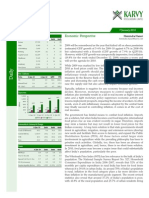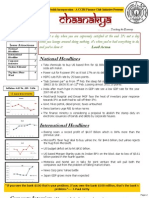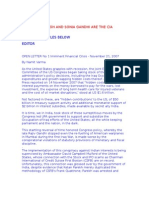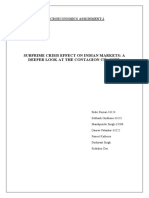Quantitative Easing Winding Up - How It Affects The Indian Markets - Yahoo India Finance
Quantitative Easing Winding Up - How It Affects The Indian Markets - Yahoo India Finance
Uploaded by
Ron ClarkeCopyright:
Available Formats
Quantitative Easing Winding Up - How It Affects The Indian Markets - Yahoo India Finance
Quantitative Easing Winding Up - How It Affects The Indian Markets - Yahoo India Finance
Uploaded by
Ron ClarkeOriginal Description:
Original Title
Copyright
Available Formats
Share this document
Did you find this document useful?
Is this content inappropriate?
Copyright:
Available Formats
Quantitative Easing Winding Up - How It Affects The Indian Markets - Yahoo India Finance
Quantitative Easing Winding Up - How It Affects The Indian Markets - Yahoo India Finance
Uploaded by
Ron ClarkeCopyright:
Available Formats
02/10/2013
Quantitative Easing winding up How it affects the Indian markets? - Yahoo India Finance
YAHOO INDIA FINANCE
Quantitative Easing winding up How it affects the Indian markets?
By Team-MoneyWorks4me | MoneyWorks4me.com Fri 21 Jun, 2013 4:51 PM IST
June 19th, 2013 was a special day. Gold hit a three-year low, the Indian Rupee hit another all-time low against the dollar and the yield on the U.S. 10-years Treasury note jumped as high as 2.46%.
Quantitative Easing
Well, is Feds statement to withdraw its quantitative easing programme by mid-2014 has got anything to do the way Sensex, Nifty and other Asian indices reacted? They should be! As the news about tapering of QE came out in open, equities all across the world started falling, with the Asian indices being hammered the most. Is this kind of market reaction justified? After all, the news wasnt a surprise; in fact quite anticipated by the market participants. Since the announcement made in May 2013, by Bernanke, the Indian stock market has shown high volatility. It crashed 383 points on 23rd May, 2013 with the earlier announcement and has further slid 5% since then. The main question is, Is the market over reacting? It, probably, is. What exactly did the Fed do? Quantitative easing basically is an extraordinary money supply experiment used by central banks to stabilize the economy. According to Monetarist, during economic slowdown, central banks lower its interest rates, which would stimulate lending and economic activity in the economy as lower interest rates encourages people to spend rather than to save. However, in case of US Federal Reserve, when interest rates could not fall further, the central bank started buying bonds to inject money into the fragile economy that was at risk of seeing financial market contagion. Theoretically, the institutions selling these bonds have, thus, increased funds, which increased money supply providing push to the lending activities, thus, the economy is set in motion. In late 2008, when the financial crisis hit, FED started buying up Mortgage Backed Securities and later on even T-bills to stabilize financial markets and to provide liquidity to the market that had entered into a financial contagion. US Fed initially reduced the interest rates to the historical low level of 0.25%. When this step also did not prove sufficient, quantitative easing was used to increase liquidity, spur borrowing and kick start the economic activity in high gear. The current monetary policy termed as QE3 is the 3rd edition of this bond shopping which the Federal Reserve has started with USD 85 billion worth of bonds being bought every month. This includes USD 40 Billion in Mortgage Backed Securities and USD 45 Billion in long term US Government securities.
in.finance.yahoo.com/news/quantitative-easing-winding-affects-indian-112155570.html 1/3
02/10/2013
Quantitative Easing winding up How it affects the Indian markets? - Yahoo India Finance
What Mr. Bernanke wants to convey? US Feds original target, while unleashing QE3, was to get the US unemployment rate down to 6.5% provided inflation expectations remain anchored below 2% rate. Now, provided Feds expectations are met by April 2014, it has signaled towards tapering of the bond purchases later this year. While most economist expected this to happen sometime in between 2014 15 but with signs of US economic revival through employment figures and housing prices stats, there has been growing clamor within the FED policy hawks to start looking at tapering and eventually withdrawal of QE3. Now, lets have a look on how Indian economic climate will face the impact of tapering of quantitative easing; High foreign debt The end of stimulus is going to adversely affect the International high yield bond market. In near future, if not immediately, normalization of interest rates in US is expected. This would put all the companies who had raised low cost floating rate debt from the global markets to use the benefit of low interest rates prevailing in the global markets in jeopardy as they should see a significant rise in their interest cost. This would mainly include companies which have, in last 2-3 years, gone for major overseas acquisition via the debt route. Indian companies raised USD 11.16 billion worth of funds overseas in FY 12-13. These low rates do not seem to be attractive any more with the bond yields on rise amid news of ending of money easing policy by US. Emerging Market (EM) currency depreciation With the yields in US T-Bills, especially TIPS (Treasury Inflation protected strips) rising above 0%; for many FIIs who had been flirting with investing in emerging markets Govt. debt markets because of positive inflation, adjusted yields would now move back to investing in US bond markets. While in near term, this would make USD stronger and EM currencies weaker. However once the structural adjustments have been made, EM currencies would stabilize at a new higher level, and EM with strong macroeconomics, is likely to see large FII inflow back in to their Debt market. This short term volatility in currencies would put pressure on the balance sheets of the companies with high USD denominated debts with no natural hedge. So, for example, because Reliance has large amount of USD denominated debt, it will not get hurt as its revenues and earnings are also in dollar terms. While Indian infrastructure companies like L&T can see their debt servicing cost increased because of higher cost in Rupee terms. FII holdings and their debt investments As treasury yields rise, the spread between US treasuries and Indian GSecs have narrowed, thus, making the debt investments in India not much an attractive option for FIIs . Indian stock markets received huge amount of FII inflows in 2012, which are likely to suffer a setback in the short term, on account of falling Rupee and Feds policy. This means that the companies that have high FII investor interests are expected to suffer. The depreciating Rupee along with announcement of slowing down of the bond-buying by Fed may trigger FIIs to withdraw from investing in Indian markets. Over last month as Nifty fell by nearly 8%, an FII investor would have seen a total loss of about 13% (8% from fall in Nifty and another 5% from fall in Rupee against USD). Banks to face the heat - Indian bonds may also experience rise in the yields as FIIs exit from Indian G-Secs (Since the start of month, the FIIs have sold net Rs. 21,000 Cr. in Debt Markets). As a result, the bond prices will go down. The banks investments in G-Secs that are accounted on the basis of Mark to Market accounting methods i.e. Available-For-Sale and Held-For-Trading Securities may see losses if Indian yields rise as a result of liquidity crunch and if RBI is forced to revers its interest rate policy stance because of continued Rupee slide. The news is not all bad In spite of all the negativity surrounding the market, it is not all that bad thing to happen to the Indian markets. The good news emerging from the US is that the US economy which was struggling since the financial crisis is now showing signs of recovery. The unemployment rate has come down to 7.6% from 9.1% in last 2 years and the GDP growth rate at 2.4%. This is likely to have trickle-down effect on the emerging market economies including India, as well. However for Indian economy, to really make the most out of this situation, it needs to fix its own house in order. Sticky consumer inflation that has not been dealt with, by the Government supply side policies, as a result, once the
in.finance.yahoo.com/news/quantitative-easing-winding-affects-indian-112155570.html 2/3
02/10/2013
Quantitative Easing winding up How it affects the Indian markets? - Yahoo India Finance
growth picks up globally, Indian economy may start heating again. Slow clearances for investments. Core reforms like labor reform, land acquisition bill has not been taken up by the Govt. over successive parliamentary sessions. Governments failure to handle existing subsidies has resulted in a very high Fiscal Deficit much beyond the target set by the Fiscal Responsibility and Budget Management Act of 2003. On the other hand, erecting new demons like NREGA and Food Security Bill without addressing the funding needs, have made these measures a pet schemes of the UPA. Over last many years, crucial tax reforms acts like double tax agreement (DTA) and goods and services tax (GST) have just been postponed due to various reasons. Its important to get these reforms out, at the earliest. In early 1990s, a similar crisis on the Foreign Exchange front had forced the Government to takes some crucial steps for reforming the slowing Indian economy. Lets hope the current crisis is used by the policy leaders to undertake crucial macro and micro reforms that can propel Indian growth for the next decade. Until then let us not be surprised with low GDP growth numbers, sticky inflation figures, volatile markets and Rupee depreciation. To know in detail, read here.
in.finance.yahoo.com/news/quantitative-easing-winding-affects-indian-112155570.html
3/3
You might also like
- Dravidian Settlements in Ceylon and The Beginnings of The Kingdom of Jaffna by Karthigesu Indrapala (Complete PHD Thesis University of London 1965)Document562 pagesDravidian Settlements in Ceylon and The Beginnings of The Kingdom of Jaffna by Karthigesu Indrapala (Complete PHD Thesis University of London 1965)Damitha K Tennakoon100% (8)
- Fce - Test 2Document14 pagesFce - Test 2lolita digiacomo0% (2)
- Summary of Anthony Crescenzi's The Strategic Bond Investor, Third EditionFrom EverandSummary of Anthony Crescenzi's The Strategic Bond Investor, Third EditionNo ratings yet
- Reliance-Trends-Project Almost FinishedDocument49 pagesReliance-Trends-Project Almost FinishedMunna Munna100% (1)
- Nawshirwan Mustafa BiographyDocument13 pagesNawshirwan Mustafa BiographyBazo Raheem100% (2)
- Impact of U.S. Fed Rate Hike On Indian EconomyDocument5 pagesImpact of U.S. Fed Rate Hike On Indian EconomyT ForsythNo ratings yet
- Evolving Bond MarketDocument9 pagesEvolving Bond MarketcoolNo ratings yet
- Assignment Day 3Document12 pagesAssignment Day 3Qazi MobeenNo ratings yet
- Thematic Insights - Welcome 2014Document3 pagesThematic Insights - Welcome 2014Jignesh71No ratings yet
- The Impact of The US Federal Policy On IndiaDocument5 pagesThe Impact of The US Federal Policy On IndiacoolNo ratings yet
- ImpctDocument2 pagesImpctManoj DarmalNo ratings yet
- ICICI Prudential Mutual Fund ArticleDocument7 pagesICICI Prudential Mutual Fund ArticleNitinNo ratings yet
- RBG Financial News LetterDocument2 pagesRBG Financial News Lettermarketing2871100% (1)
- Global Economic Crisis and Indian EconomyDocument11 pagesGlobal Economic Crisis and Indian EconomyabhaybittuNo ratings yet
- Empower June 2012Document68 pagesEmpower June 2012pravin963No ratings yet
- Business Line JulyDocument7 pagesBusiness Line JulyRaj KishoreNo ratings yet
- Quantitative Easing (QE) Is An UnconventionalDocument16 pagesQuantitative Easing (QE) Is An Unconventionalkanchanagrawal91No ratings yet
- Global Marketplace: Contradictions Galore & Policy JittersDocument5 pagesGlobal Marketplace: Contradictions Galore & Policy JittersAmit BhushanNo ratings yet
- India's Inclusion in JP Morgan's Emerging Market Bond IndexDocument8 pagesIndia's Inclusion in JP Morgan's Emerging Market Bond IndexvijayhydofficeNo ratings yet
- Why S&P Downgraded The US, and What It Means For India: Source: WikipediaDocument38 pagesWhy S&P Downgraded The US, and What It Means For India: Source: WikipediaNilesh ThoraveNo ratings yet
- Niveshak Niveshak: India Vision 2020Document24 pagesNiveshak Niveshak: India Vision 2020Niveshak - The InvestorNo ratings yet
- Exchange RateDocument6 pagesExchange RateChirag HablaniNo ratings yet
- Central BankingDocument13 pagesCentral BankingRiddhi DaniNo ratings yet
- The Recent Depreciation of The INR Against The USD: An Analysis of Currency FluctuationsDocument4 pagesThe Recent Depreciation of The INR Against The USD: An Analysis of Currency FluctuationsRaeesudheenNo ratings yet
- Rupee Depriciation and Its ConsequencesDocument7 pagesRupee Depriciation and Its ConsequencesAkriti ChandraNo ratings yet
- Growth Environment Remains Weak in Near FutureDocument4 pagesGrowth Environment Remains Weak in Near FuturethefinapolisNo ratings yet
- A Sensex Gone Awry - The Hindu Dated 04 NOV 2013Document2 pagesA Sensex Gone Awry - The Hindu Dated 04 NOV 2013kvinodan73No ratings yet
- HSBC India - Jan-March 2012 Issue of Wealth StrategiesDocument44 pagesHSBC India - Jan-March 2012 Issue of Wealth StrategiesRohitava SahaNo ratings yet
- Helping You Spot Opportunities: Investment Update - October, 2012Document56 pagesHelping You Spot Opportunities: Investment Update - October, 2012Carla TateNo ratings yet
- Daily: Economic PerspectiveDocument3 pagesDaily: Economic PerspectiveDEEPAK KUMAR MALLICKNo ratings yet
- Good Newspapers ArticlesDocument151 pagesGood Newspapers ArticlesManish YadavNo ratings yet
- India Struggles To Avoid Curse of StagflationDocument8 pagesIndia Struggles To Avoid Curse of StagflationSohil KisanNo ratings yet
- Awm House View - q3 Fy25Document35 pagesAwm House View - q3 Fy25saurav8912sharmaNo ratings yet
- The Structure and Functions of The Federal Reserve System: Policy, Banking Supervision, Financial ServicesDocument18 pagesThe Structure and Functions of The Federal Reserve System: Policy, Banking Supervision, Financial ServicesJapish MehtaNo ratings yet
- Analyze Trend of Rupee VS DollarDocument7 pagesAnalyze Trend of Rupee VS DollardeomathewsNo ratings yet
- BlogDocument4 pagesBlogShabih FatimaNo ratings yet
- What Causes Currency To Increase/decrease On A Daily Basis?Document5 pagesWhat Causes Currency To Increase/decrease On A Daily Basis?Deepak Nagathihalli ChandruNo ratings yet
- C O M P A N Y P R O F I L E: Achal Gupta Managing Director & Chief Executive OfficerDocument61 pagesC O M P A N Y P R O F I L E: Achal Gupta Managing Director & Chief Executive OfficervipinkathpalNo ratings yet
- Subprime Crisis & Its Implication On IndiaDocument4 pagesSubprime Crisis & Its Implication On IndiaNaina SharmaNo ratings yet
- How US Markets Affect Indian Stock MarketDocument14 pagesHow US Markets Affect Indian Stock MarketdiptidevNo ratings yet
- Monetary Policy and Role of Banks: February 2015Document7 pagesMonetary Policy and Role of Banks: February 2015anik24No ratings yet
- Optimism Prevails As Neda Chief Confident PH Will Hit Growth Target - Sept 19, 2019Document8 pagesOptimism Prevails As Neda Chief Confident PH Will Hit Growth Target - Sept 19, 2019Mavic PeñalozaNo ratings yet
- LinkDocument24 pagesLinkDhileepan KumarasamyNo ratings yet
- Impact of Recession On Indian Stock-MarketDocument14 pagesImpact of Recession On Indian Stock-Marketmayank chopraNo ratings yet
- New Draft Stock MarketDocument12 pagesNew Draft Stock Marketmayank chopraNo ratings yet
- Why Rates FluctuateDocument2 pagesWhy Rates Fluctuateprajaktabansod.89No ratings yet
- Impact of Recent Global Slump On Indian Capital MarketDocument70 pagesImpact of Recent Global Slump On Indian Capital MarketVandana Insan100% (3)
- 12 - 16th February 2008 (160208)Document5 pages12 - 16th February 2008 (160208)Chaanakya_cuimNo ratings yet
- Tracking The World Economy... - 13/08/2010Document3 pagesTracking The World Economy... - 13/08/2010Rhb InvestNo ratings yet
- The Federal ReserveDocument3 pagesThe Federal Reservemahikukreja5No ratings yet
- India Market Outlook Aug 2013Document4 pagesIndia Market Outlook Aug 2013sindu_lawrenceNo ratings yet
- Business Ethics AND Corporate Governance: TopicDocument7 pagesBusiness Ethics AND Corporate Governance: TopicJohn PrarthanNo ratings yet
- Manmohan Singh and Sonia Gandhi Are The CIA Agents of UsaDocument13 pagesManmohan Singh and Sonia Gandhi Are The CIA Agents of UsaSogno100% (3)
- Asia Economics Comment: Don't Sweat An Early TaperDocument4 pagesAsia Economics Comment: Don't Sweat An Early TaperSwapnilNo ratings yet
- Subprime Crisis Effect On Indian Markets: A Deeper Look at The Contagion ChannelDocument14 pagesSubprime Crisis Effect On Indian Markets: A Deeper Look at The Contagion ChannelMangesh GulkotwarNo ratings yet
- Helping You Spot Opportunities: Investment Update - August, 2013Document55 pagesHelping You Spot Opportunities: Investment Update - August, 2013akcool91No ratings yet
- Impact of Demonetization On Indian Debt MarketDocument22 pagesImpact of Demonetization On Indian Debt MarketTaruna Juneja100% (1)
- Investment: Buffett: Buying Bonds Here Is A MistakeDocument21 pagesInvestment: Buffett: Buying Bonds Here Is A MistakeVivekNo ratings yet
- Speak of The Week Aug 10-2012Document3 pagesSpeak of The Week Aug 10-2012Bonthala BadrNo ratings yet
- Senior Analyst January 2012Document51 pagesSenior Analyst January 2012Arpan BhagatNo ratings yet
- Finvest Times: Letter To ReadersDocument8 pagesFinvest Times: Letter To ReadersKrishna KumarNo ratings yet
- SuccessionDocument24 pagesSuccessiondinvNo ratings yet
- Chapter 4. Problem SolvingDocument7 pagesChapter 4. Problem Solving.....No ratings yet
- Kunci Pathway Wajib X K13NDocument39 pagesKunci Pathway Wajib X K13Nmochamadmusyaffa100% (1)
- Sample Paper EnglishDocument6 pagesSample Paper EnglishAmogh Karigoudar100% (1)
- Making Sense of Market IntelligenceDocument13 pagesMaking Sense of Market IntelligenceAida ArguetaNo ratings yet
- The Second ComforterDocument14 pagesThe Second ComforterastroboytemnaNo ratings yet
- English 7 LPDocument7 pagesEnglish 7 LPLyjean ManigoNo ratings yet
- Worksheet Writing - Supporting DetailsDocument6 pagesWorksheet Writing - Supporting DetailsSahrulRashidNo ratings yet
- Law Hon Gong, The Mo NK'S Strength: by Jon FunkDocument5 pagesLaw Hon Gong, The Mo NK'S Strength: by Jon FunkTom Hill100% (1)
- A Source Book KrishnaDocument590 pagesA Source Book KrishnaSubhankar Bose75% (8)
- Chapter 14 - Noise Pollution and ControlDocument8 pagesChapter 14 - Noise Pollution and ControlrudypatilNo ratings yet
- Principles of Research WritingDocument13 pagesPrinciples of Research WritingmmgcelesteNo ratings yet
- EnzymeDocument23 pagesEnzymevivin100% (1)
- Group ThinkDocument26 pagesGroup ThinkSurbhi SabharwalNo ratings yet
- Appendix X BB CHP Self-PetitioningDocument31 pagesAppendix X BB CHP Self-PetitioningLuisa Elena HernandezNo ratings yet
- Robust Frequency and Timing Synchronization For OFDM - Timothy M. SchmidlDocument9 pagesRobust Frequency and Timing Synchronization For OFDM - Timothy M. SchmidlLuu Van HoanNo ratings yet
- Mental Status Examination & Case HistoryDocument11 pagesMental Status Examination & Case HistoryAsuna KoreishiNo ratings yet
- Question BankDocument8 pagesQuestion BankSiddharth MehtaNo ratings yet
- Bettenhausen 1991 - Five Years of Group Research - What We Have Learned and What Needs To Be AddressedDocument37 pagesBettenhausen 1991 - Five Years of Group Research - What We Have Learned and What Needs To Be AddressedBarry HemmingsNo ratings yet
- Regulating Surrogacy: Critical AnalysisDocument7 pagesRegulating Surrogacy: Critical AnalysisSamuel DavisNo ratings yet
- Anemia in Chronic Kidney DiseaseDocument38 pagesAnemia in Chronic Kidney DiseaseHemodialisa LindimaraNo ratings yet
- Crucible VocabularyDocument3 pagesCrucible Vocabularyezaloca1106930% (1)
- 9:11: The View From The Midwest - Politics News - Rolling StoneDocument6 pages9:11: The View From The Midwest - Politics News - Rolling StoneantelopehueNo ratings yet
- 6A1 A Noticeboard MessageDocument3 pages6A1 A Noticeboard MessagegeoffNo ratings yet
- Topic 4: Random Effects and The Hausman Test The Hausman TestDocument10 pagesTopic 4: Random Effects and The Hausman Test The Hausman TestShafqat BukhariNo ratings yet
- (Ebooks PDF) Download Supervision Today! 9th Edition (Ebook PDF) Full ChaptersDocument49 pages(Ebooks PDF) Download Supervision Today! 9th Edition (Ebook PDF) Full Chaptersatomboirger100% (5)

























































































